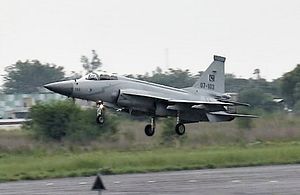Saudi Arabia is reportedly considering purchasing the JF-17 Thunder fighter jet that was jointly produced by China and Pakistan.
According to a report in World Tribune, the Saudi Defense Ministry and Royal Saudi Air Force are reviewing the JF-17 program and considering becoming a partner in it. The report said that Pakistan had offered the JF-17 fighter to Saudi Arabia with technology transfer and co-production.
The offer apparently occurred when Saudi Deputy Defense Minister Prince Salman Bin Sultan visited Pakistan earlier this week. Prince Bin Sultan reportedly toured the JF-17 program while in the country.
The Diplomat could not confirm the report, which World Tribune said was based on interviews with “officials,” without specifying any nationalities. World Tribune is a conservative U.S.-based online newspaper focusing on exclusive and underreported international stories involving strategic affairs. It was founded in 1998 by Robert Morton, formerly the Associate Publisher and a Corporate Editor at the Washington Times, which has a history of reporting on alleged secret defense deals between Pakistan and Saudi Arabia. Some observers, including The New Yorker, have questioned World Tribune’s credibility.
If the report is accurate, this would represent a potential significant strategic shift from Saudi Arabia, which has traditionally relied on U.S. and Western defense technology for its military needs. The Royal Saudi Air Force, for example, is largely organized around its massive fleet of Boeing F-15 Eagles, with a couple European fighters also thrown into the mix. As recently as September 2010, the U.S. announced a $60 billion arms deal with Saudi Arabia, which included the sale of 84 new F-15s and upgrades on 70 of Saudi Arabia’s existing ones. It was the largest arms deal in U.S. history.
In his new memoir, Robert Gates describes a 2010 meeting where Saudi leader King Abdullah agreed to the enormous arms purchase. Gates said the king’s advisers wanted him to buy French or Russian jets, but King Abdullah opted for the U.S. ones because, according to Gates, “he saw the huge purchase as an investment in a long-term strategic relationship with the United States, linking our militaries for decades to come.”
Still, since that time U.S.-Saudi ties have soured amid disagreements over Iran, Syria and Palestine. In October of last year, the Wall Street Journal reported that “the Saudis told the U.S. that they were open to alternatives to their long-standing defense partnership, emphasizing that they would look for good weapons at good prices.” Then, shortly after the P5+1 and Iran inked an interim agreement on the latter’s nuclear program in November, an advisor to the Saud family told reporters that Saudi Arabia is looking for other allies besides the U.S. Many believe that the Saudi government views Pakistan as a more reliable strategic ally than the United States.
Pakistan, for its part, has long been trying to find countries to buy the JF-17 in order to reduce the per-unit cost the Pakistan Air Force pays for procuring the plane.
As The Diplomat reported back in October, the Pakistani Air Force expects to begin exporting the aircraft this year. A report that ran in multiple Pakistani newspapers at the time said: “The Pakistan Air Force has been assigned [a] target of exporting 5 to 7 JF-17 Thunder planes next year and discussions in this regard are under way with Sri Lanka, Kuwait, Qatar and other friendly countries.”
Yet China and Pakistan have long struggled to find customers for the JF-17, which China calls the FC-1. This hasn’t been for lack of trying, as the two countries have aggressively marketed the plane over the last few years. For example, a Flight Global article in 2010 said that China was in negotiations with the Democratic Republic of Congo, Nigeria, the Philippines, Sri Lanka, Sudan and Venezuela, while Pakistan was in talks with Turkey and Egypt. Later there were reports that Argentina and China were in talks about a co-production deal for the FC-1, while Indonesian Defense Minister Purnomo Yusgiantoro confirmed Pakistan had offered his country the JF-17, saying it was superior to the U.S. F-16.
Last month, when rolling out the Block-II JF-17 aircrafts, the project director, Air Vice Marshal Javaid Ahmad, said that “several countries in Central Asia, South America and Africa had shown interest in buying the new plane.”
Although Saudi Arabia is rarely mentioned in these reports, there have been some rumors that Saudi Arabia is interested in buying the aircraft. Indian media outlets, quoting Russian industry publications, reported in 2010 that Russia had blocked sales of its RD-93 engines to China over concerns that the JF-17/ FC-1 would compete in international markets with Russia’s own MiG-29.
The Indian reports quoted Russia’s state arms export monopoly, Rosoboronexport (ROE), as saying in a press release: “Under the inter-governmental bilateral agreement in November 2007 China was allowed to re-export RD-93 as part of FC-1 fighter to Egypt, Nigeria, Bangladesh, Saudi Arabia and Algeria.”
Pakistani JF-17s have also periodically made re-fueling stops in Saudi Arabia.
































